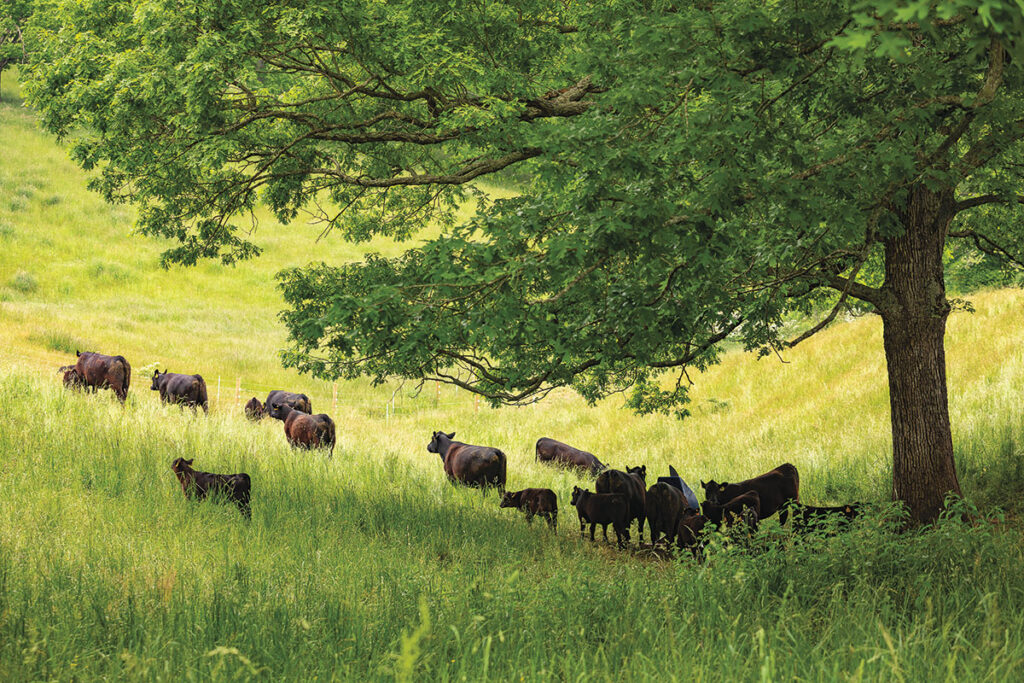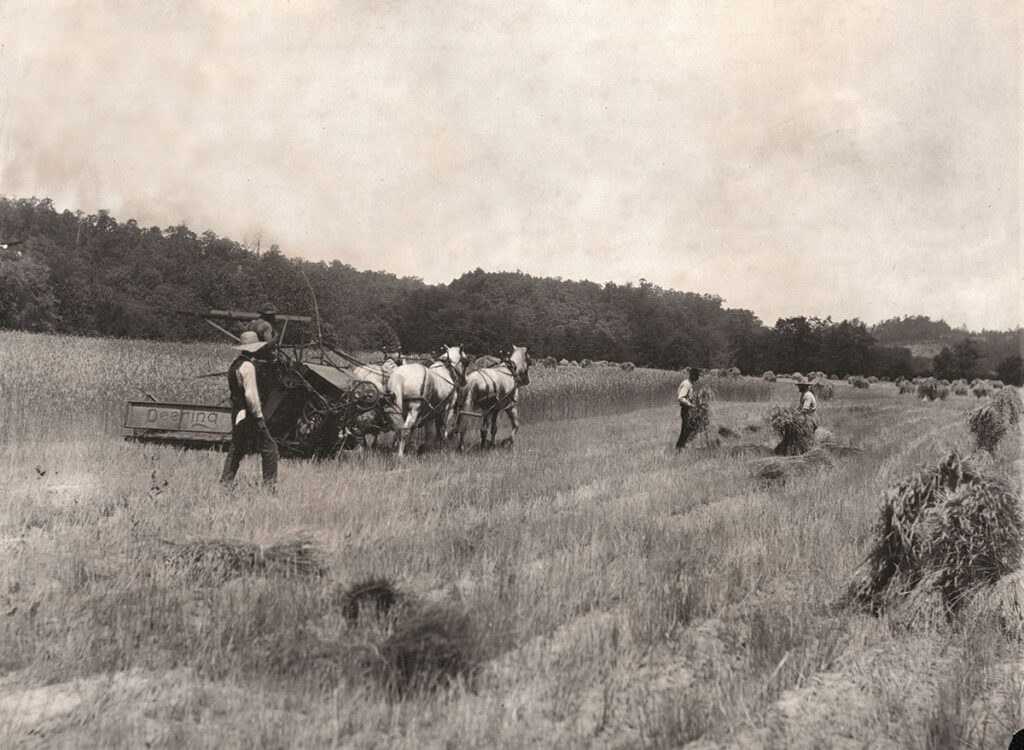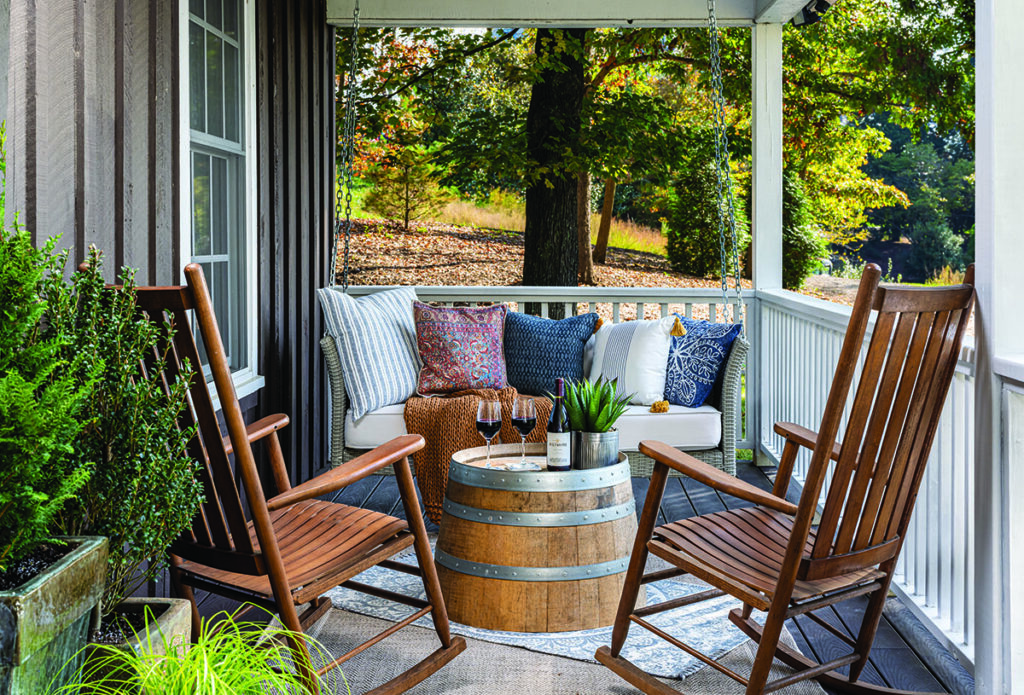Article:
PICTURED ABOVE: Biltmore’s Village Social restaurant offers a colorful array of dishes, ingredients for which are sourced from the estate’s farms. Photo courtesy of the Biltmore Company.
Top of the Food Chain
BY NAN K. CHASE | PHOTOS COURTESY OF THE BILTMORE COMPANY UNLESS OTHERWISE NOTED
If meals at the fabled Biltmore Estate taste especially fresh and flavorful, it’s because they are fresher and more flavorful than typical fare. In Asheville, a city obsessed with its reputation for farm-to-table culinary excellence—locally grown and sustainable—the most remarkable food story of all is hiding in plain sight.
Nurturing a self-sustaining food production system, Biltmore Estate today has returned to the intent of its creator, George Washington Vanderbilt. As Vanderbilt set out to build an advanced agricultural operation in the late 1800s, he restored more than 100,000 acres of ravaged mountainsides to productive farmland and forest.

Nowadays, the estate is known primarily as a top North Carolina tourist destination, where more than a million visitors per year flock to Vanderbilt’s Gilded Age mansion, recognized as one of the largest private homes in the country. Step away from the house, however, and the full scope of the estate’s agricultural production comes into focus.
The back half of the estate, on the far side of the French Broad River from the mansion and its ornamental landscaping, is the site of livestock operations that help supply various dining establishments for visitors: 300 Black Angus cows, a dozen breeding bulls and their offspring; a dozen breeding Berkshire sows and two boars, plus their young; and 120 ewes, three rams and their twice-a-year production of lambs. Add thousands of acres of sunny pastureland, along with the row crops that produce hay, corn, barley, soybeans, wheat and rye for the animals’ custom feed mixes, and you have a booming farm within shouting distance of Asheville’s shopping malls and suburban housing developments.
Kyle Mayberry, the estate’s director of agriculture and a North Carolina State University graduate, is proud of the humane farming methods that are meant to keep animals content and productive until the moment they are harvested for food. Swine—kept together in their original litters—root for acorns in wooded paddocks for six months at a time. Cattle graze with their young in open fields. Sheep wander beneath the estate’s 13-acre solar collector array under the watchful eyes of five shaggy white guard dogs. The farm also houses its own beehives. “We are keeping George Vanderbilt’s dream alive,” says Mayberry. “We want to show it to people.”
The estate produces more than just livestock. Thanks to its managed forest plan—which began with the nation’s first large-scale forestry management system, established in the late 19th century—some 6,000 acres of carefully tended, mixed woodland now produce oak timber that’s fashioned into barrels for aging the estate’s own wines. Seeds from the sunflowers grown on-site are now pressed and used for food-grade finishing oils and vinaigrettes.
Then there’s the produce. A complex of greenhouses—8,000 square feet in all—yields a steady supply of salad greens, tomatoes, live microgreens and herbs for the estate’s salads. That adds up to 1,000 heads of lettuce a week, while the greenhouses produce crops of baby bok choy and other delicacies. Biltmore-grown basil is harvested twice a week for “export” to a local company that makes blueberry-basil soda. Pest control inside the greenhouses comes from flats full of a pungent mix of watercress and garlic. Outside, critter-proof crops like edible flowers and horseradish don’t need pampering.

Field-to-table manager Sarah Woodby proudly oversees this bountiful year-round cycle of intensive growing, which she describes as “40% less water, 40% faster and 40% larger” than plants grown outdoors in soil. Hydroponic techniques use sterile growing media to hold seedlings gently in place as water-soluble nutrients cycle around their roots. “It’s like baby formula,” she says. “For each plant we calculate their individual needs, and there’s no field runoff.”
As a child on a North Carolina tobacco farm, Woodby grew up handling seeds and plants. Now she applies that knowledge with an artist’s touch. “We could streamline and mechanize with things like vacuum seeders, to plant individual seeds. But that’s not the human touch. We’re all about quality. We’re not about quantity. It’s not how fast, but how good. So, for instance, we use tweezers for placing seeds by hand,” she says. Woodby meets with the Biltmore chefs several times a year to coordinate the crops she needs to grow for the menus they want to create. The chefs like Cherokee purple tomatoes, so that’s what she grows, even though that variety is not typically raised hydroponically. Her staff can even grow crops timed for specific event menus.
Overseeing menu development for the estate’s dining facilities, from casual burger and snack outlets to pub fare and banqueting, the estate’s executive chef, Mark DeMarco, draws on the fresh fare around him to offer well-crafted dishes with superb flavor. Savory soup stocks, for example, come from the bones of the livestock raised and butchered at the estate. The salads are almost sweet, and the lamb-rich shepherd’s pie is tender. “A hundred percent of the ground beef served on the estate is from our beef,” he says. “Our biggest struggle is producing out-of-season fruits and vegetables.”


The supply chain challenges of COVID-19 forced DeMarco and his staff to become creative, making the most of nearby food sources. “It made the chef team a lot more resourceful,” he says. Another new development is a major effort to compost not only all of the estate’s agricultural and landscaping byproducts, but more and more discarded foodstuffs. The estate’s on-site composting facility produces 1,200 tons of finished compost a year, which in turn gets spread onto crop fields, pastures and landscape beds—an efficient closed loop that George Vanderbilt would have lauded.
Once upon a time, over a century ago, Biltmore Estate wagons trundled through the streets of Asheville with produce for sale to the public and deliveries of rich dairy products from Vanderbilt’s prize-winning, 2,000-strong dairy herd. Meanwhile, as Mr. and Mrs. Vanderbilt sat down for meals, they could enjoy the satisfaction of delicious homegrown food from their own backyard, including poultry and game. An 1897 newspaper article heaped on the praise: “It is Vanderbilt the farmer, not Vanderbilt of the Chateau, who has proven to be the great benefactor of western North Carolina … Today he is the best farmer in the South.”
Today’s estate does more than preserve the home and grounds for tourism purposes—it preserves Vanderbilt’s legacy in farming and forestry for future generations.
The Biltmore Farm to Table Tour & Taste experience lets visitors see the cattle and hog farming operations, hydroponic greenhouses and estate vineyards. Stay in the country by booking any of four recently restored agricultural cottages on the estate and enjoy a tour and a sip and taste!
Visit biltmore.com/activity/farm-to-table-tour-taste and biltmore.com/stay/cottage to learn more.
Pictured below: Visitors can experience Biltmore’s agricultural history in a unique way by staying in cottages originally inhabited by people who ran the farm.






